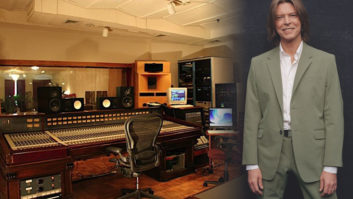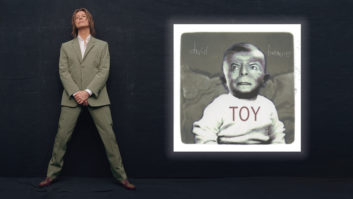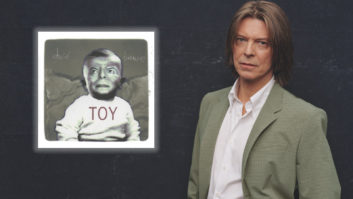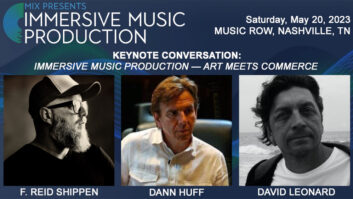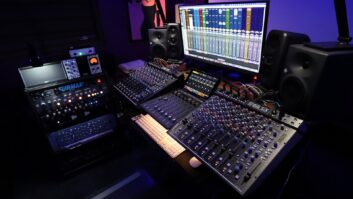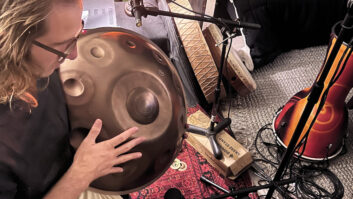A logo from the free t-shirt given to everyone who attended the BowieNet gig.

With the passing of David Bowie from cancer at age 69 this week, everyone’s naturally thinking back to his heyday of the Ziggy Stardust era through the early 1980s with Let’s Dance, but it’s fair to remember that he also had an artistic renaissance in the late Nineties and early 2000s, issuing a spate of experimental albums and touring the world with the itineraries and energy of a man half his age. What follows here is Pro Sound News‘s coverage of a special one-off gig in New York City in June, 2000, taken from our August issue that year.
David Bowie has worn many guises over the years, from Ziggy Stardust to The Thin White Duke. These days, you can also call him “Sailor”—his screenname on www.davidbowie.com, which has now been relaunched as BowieNet, a full-fledged internet service provider. As a ‘thank you’ for the ISP’s subscribers—and an opportunity to get in a little practice before appearing at England’s Glastonbury Festival—Sailor held a special BowieNet members-only show at New York’s Roseland Ballroom in June. Between Bowie’s riveting performance, the guitar fireworks of Earl Slick and the surprise appearance of New Wave legend Thomas Dolby for “Heroes” and “Let’s Dance,” it was definitely a night to remember.
Steve Guest, hours before the BowieNet gig, with his Yamaha PM4000 Console.
Providing sound for the event was FOH engineer Steve Guest, presiding over an ATK/Audiotek-provided PA and Firehouse Productions-provided control set-up. The two companies have had an on-going partnership in recent times, which has resulted in them collaborating on a number of projects, including the Cure’s Bloodflowers tour .

While the BowieNet show was an event unto itself, the goal of preparing for Glastonbury was a top priority for the evening. “I was told we’d have a Yamaha PM4000 at the Glastonbury Festival, so I chose to mix on one here as well,” Guest noted. “That way, I can chart the board and re-create it over at Glastonbury—we won’t have to carry a console with us, because they’re very difficult to haul in at a festival.”
The outboard effects package consisted of an Eventide H-3000DSE, a Lexicon PCM 91 digital reverb, and a Roland SDE330 digital delay, all solely for Bowie’s vocal effects. Then there’s a Yamaha SPX990 for drum effects, a Yamaha REV500 for general instrument reverb, a dbx 120XP subharmonic synthesizer, a Zoom 9050 (“It’s David’s and I only use it on ‘Hallo Spaceboy'”), and a Yamaha 01V as the effects mixer. Guest explained, “All but the 990 and 120 return to the 01V, and the effects mix is changed for each song. I use a battery-powered MIDI program changer which sends a program change to the 01V to change the effects mix. It passes the program change to the effects rack, changing programs on all the effects units for that particular song. Each song has an associated MIDI program number and all the effects units except the 120 are MIDI linked and enabled.” Guest added that he was also using some of the Pro R3-like internal effects on the 01V as well.
Despite the many different styles of music performed through out the evening, Guest provided a consistency to the sound by aiming for one thing: “I try to make it a clean mix, and keep it as clear as I can because there’s a lot of information sometimes. The V-Dosc helps that quite a bit.” The sizable L-Acoustic V-Dosc PA system, powered by a slew of QSC power amplifiers, handled everything that Guest and the band threw at it with equal aplomb.
Guest, who also mixed tours for the Outside and Earthling albums in recent years, has developed a specific set-up for Bowie’s voice, ensuring that the singer’s voice sounds as it should. “I use an ATI Pro-6 pre-amp to receive the microphone directly; this feeds a Meyer CP-10 parametric EQ, which in turn feeds a Drawmer 1960 tube compressor. Also there’s a Klark-Teknik unit used as a side-chain EQ to the 1960 compressor, and the line level signal from the rack comes back to a channel insert on the console so that I’m not really using the pre-amp in the console. I started doing that when we were doing the ’96-’97 rock festivals. At rock festivals, you’re never sure of what console will be there, but with this arrangement, it really gives David’s vocal a high level of consistency. I can spend more time getting the other parts of the mix together, because his vocal is always just right with that arrangement.”
Helping get Bowie’s voice across was a Shure Beta 58A (“That’s a good mic for him”), while backing vocalists were put on the new Shure 87C, of which Guest noted, “I’m pretty happy with it—it’s a good mic.”
Monitor engineer Mike Prowda concurred, “The mic is a condenser version of the SM58—it doesn’t have the extreme peak that the original 87 had, which seemed to cause problems if you were using it on a liver stage. I used this on the Eagles and I did a show with Carly Simon earlier this year and she’s very particular. I stuck in front of her and she was, ‘Oh, this is cool!’ I think you’ll hear a lot about this; they’ve struck on a good product.”
Prowda mixed the band on a Midas Heritage 3000, providing personal monitor mixes for the entire band. Most of the group wore Ultimate Ears UE-5 ear buds with Garwood Radio Stations and Shure PSM700 systems, for a total of nine radio systems between the band and technicians, not including the drummer and keyboardist’s hardwired systems.
While Prowda had a few effects such as a Lexicon PCM90 and a Summit TLA100 on Bowie’s vocal, in fact the man himself handled some of his effects, too. “David does his own vocal effects on stage,” Prowda reported. “He has a few pedals that run through effects that he’s selected, and he can blend it himself. I set the level and the input runs out of a bus on my desk into the vocal effects—a Vocalist and a Moog effect that he uses. So it’s a pre-set level that goes into the effect, comes through his volume pedal, and…he can bring it in and out to blend it for himself and for the FOH. That way, if it sounds right for himself, that’s basically the blend that he wants the FOH to have. It’s kind of neat.”
The quick run of concerts marked the end of promotion for last year’s Hours… album; Bowie now claims he’s going to lay low for the next 18 months at least. For Guest, who’s also mixed the likes of Janet Jackson, Ricky Martin, Bette Midler, Paula Abdul and David Sanborn, no doubt there’s other acts he’ll be mixing until that moratorium is up. Nonetheless, he paused for a moment, just before soundcheck started, and mused, “I’ve been very fortunate with the people that I’ve worked for, and I’ve enjoyed all of it. I love working with David—he’s an incredible guy, he really is.”

